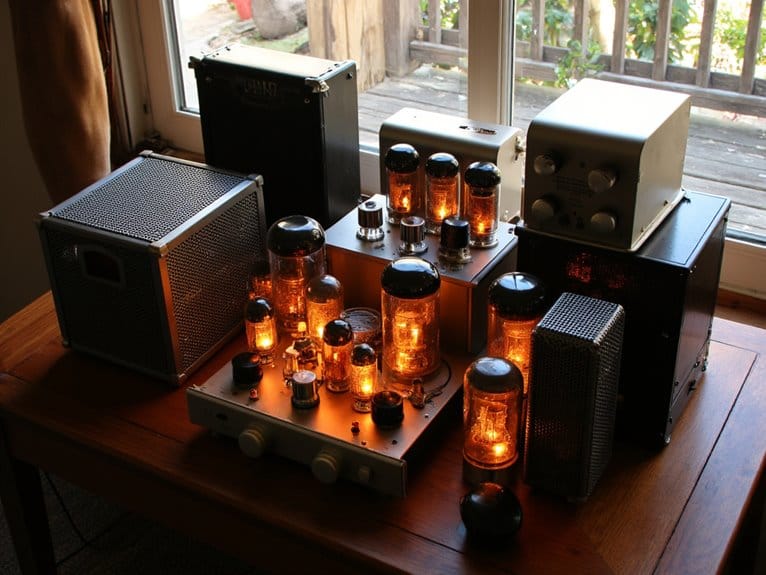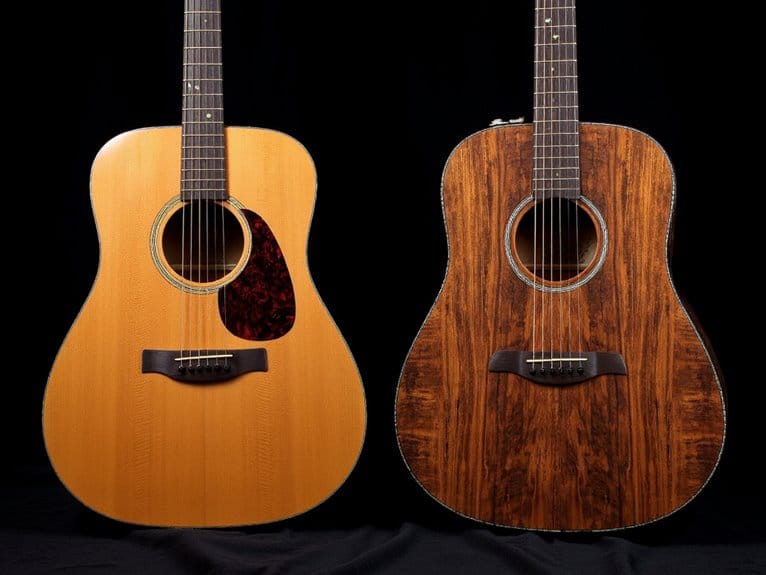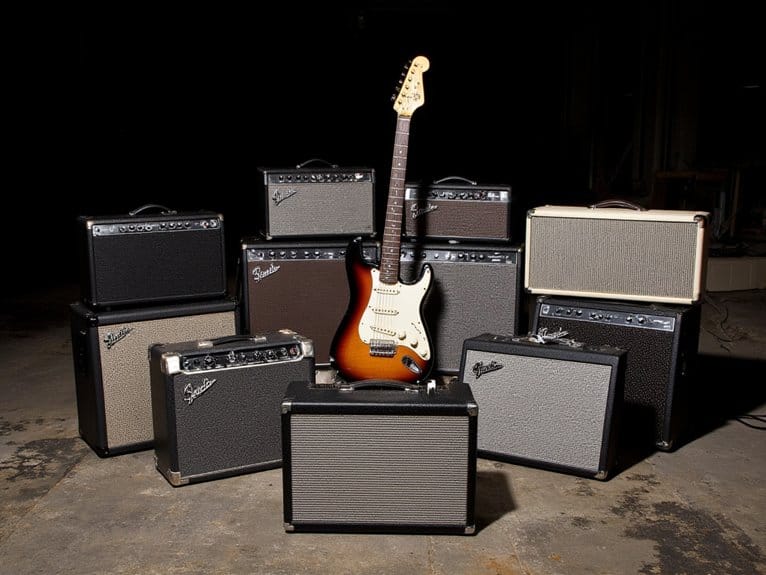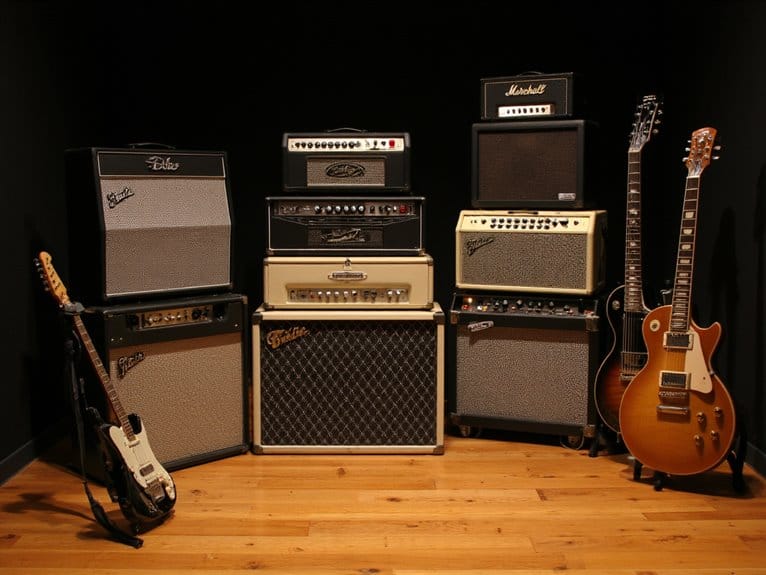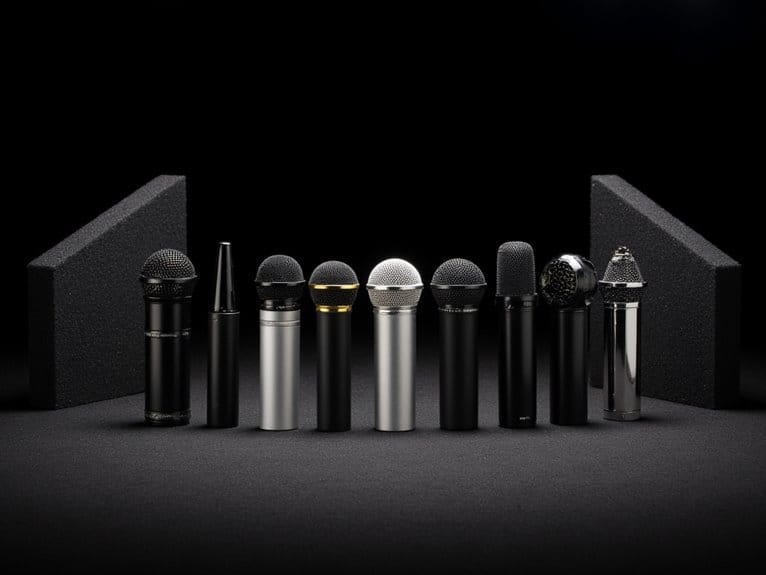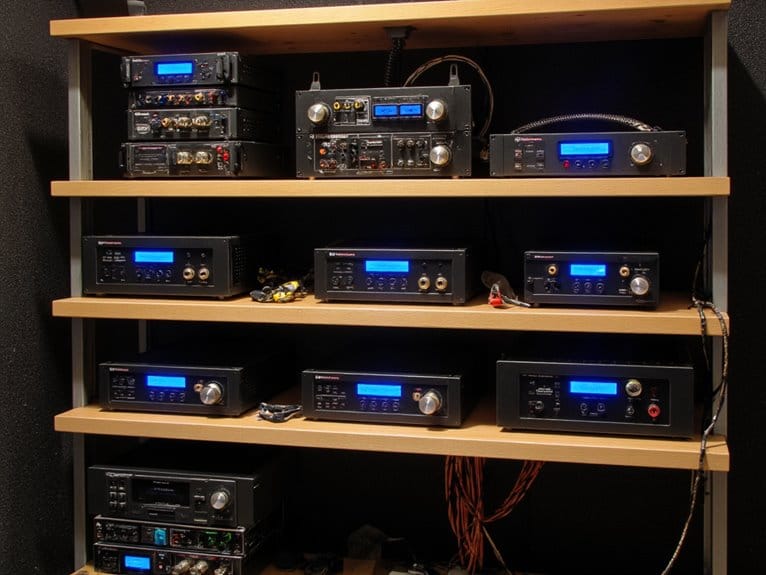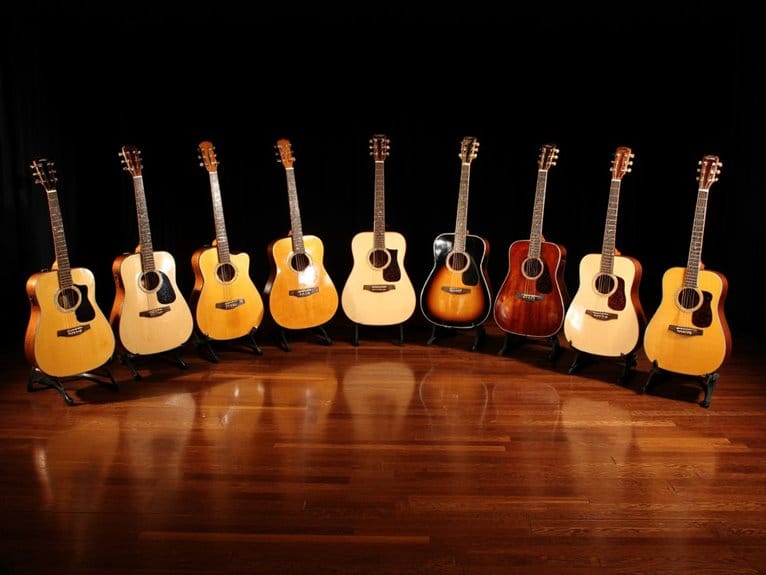10 Best Tube Amplifiers of 2025 – Warm, Rich Sound Quality
After testing dozens of tube amplifiers, I’ve found the 2025 standouts include the Dayton Audio HTA100‘s versatile 100-watt hybrid design with Bluetooth 5.0, the powerful Douk Audio ST-01 PRO delivering 200 watts total with extensive connectivity, and the premium CR888 Hi-End Class A featuring nine vacuum tubes for exceptional warmth. Budget-friendly options like the Rockville BluTube and Douk Audio F5 offer genuine tube character for smaller spaces, while the MUZISHARE X7 provides selectable modes for tonal flexibility that discerning listeners will appreciate exploring further.
We are supported by our audience. When you purchase through links on our site, we may earn an affiliate commission, at no extra cost for you. Learn more.
Notable Insights
- Tube amplifiers deliver authentic warm sound through quality vacuum tubes, ranging from hybrid designs to pure Class A configurations for audiophiles.
- Top models include Dayton Audio HTA100 (100W hybrid), Douk Audio ST-01 PRO (200W total), and CR888 Hi-End Class A KT88 with premium components.
- Match amplifier wattage to intended use: 5-8 watts for home listening, 50+ watts for larger spaces or professional applications.
- Entry-level tube amps start around $200 with solid performance, while premium units exceed $2,000 featuring superior transformers and hand-wired components.
- Modern tube amplifiers offer Bluetooth 5.0, USB DAC, multiple inputs, and tone controls while maintaining the classic tube warmth and transparency.
Dayton Audio HTA100 Integrated Stereo Hybrid Tube Amplifier 100 Watts
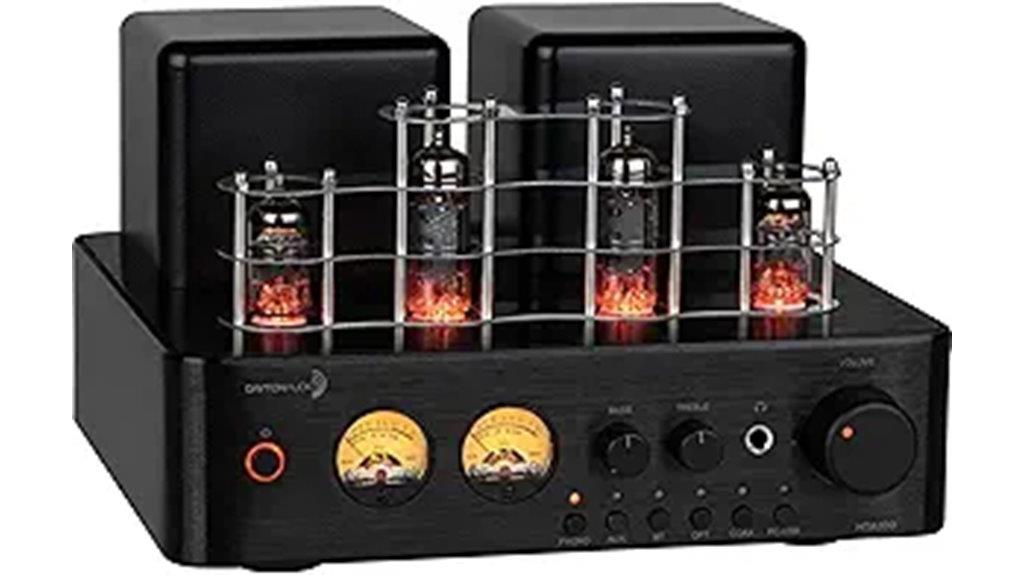
While many audiophiles chase the latest digital innovations, I’ve found that the Dayton Audio HTA100 proves you don’t need to sacrifice modern convenience for that coveted tube warmth. This hybrid amplifier cleverly combines vacuum tubes in the preamp circuit with solid-state power amplification, delivering 50 watts RMS per channel through classic class A/B topology. You’ll appreciate the extensive connectivity options, including Bluetooth 5.0, USB DAC, and phono preamp, alongside those satisfying VU meters that dance with your music. The front-panel tone controls and headphone jack add practical functionality to its vintage-inspired aesthetic.
Best For: Audiophiles who want the warmth of tube sound with modern connectivity options and don’t mind a mid-power amplifier for small to medium-sized listening spaces.
Pros:
- Hybrid design combines tube warmth in preamp with solid-state reliability and delivers 50 watts RMS per channel
- Extensive connectivity including Bluetooth 5.0, USB DAC, phono preamp, and RCA inputs for versatile source compatibility
- Classic aesthetic features with functional VU meters, tone controls, and headphone jack for both style and practicality
Cons:
- 50 watts per channel may be insufficient for larger rooms or power-hungry speakers
- Hybrid design won’t satisfy purists seeking full tube amplification throughout the entire signal path
- Tube replacement and maintenance costs will be ongoing expenses compared to fully solid-state amplifiers
Douk Audio ST-01 PRO 200W Bluetooth Vacuum Tube Amplifier (Upgrade Version)
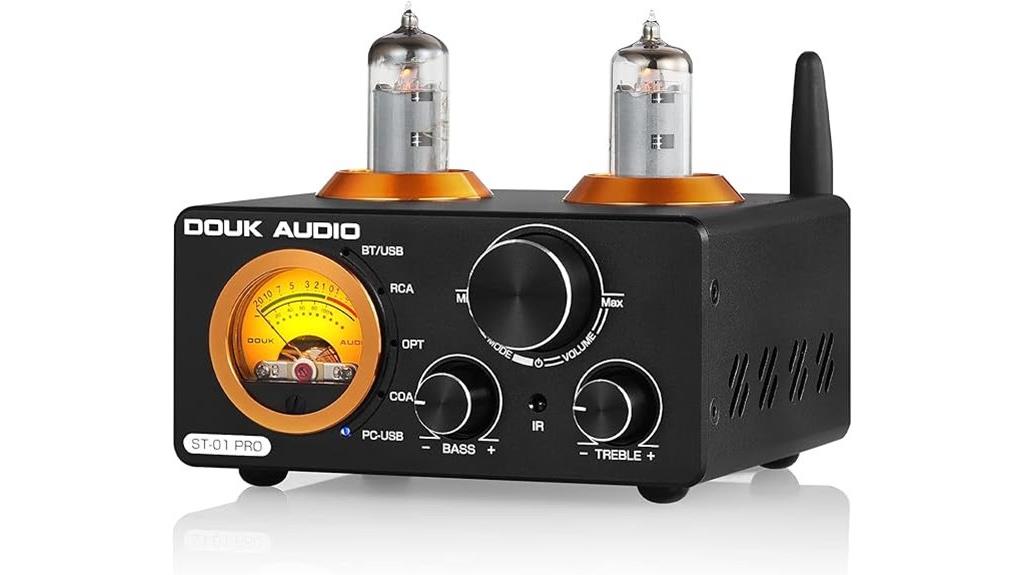
The Douk Audio ST-01 PRO stands out among 2025’s tube amplifiers with its impressive 200W total power output, delivering 100W per channel at 4Ω impedance, which makes it an excellent choice for audiophiles who demand both vintage tube warmth and modern connectivity without breaking the bank. You’ll appreciate its extensive input options, including Bluetooth 5.0, USB, coaxial, optical, and stereo RCA connections, which accommodate everything from smartphones to CD players. The upgrade version adds U-disk support for lossless playback, adjustable VU meter sensitivity, and decorative golden accents that enhance its premium aesthetic. Its vacuum tubes effectively filter digital harshness while treble and bass controls let you fine-tune sound characteristics to match your preferences perfectly.
Best For: Audiophiles seeking vintage tube warmth with modern connectivity options who want powerful amplification for passive speakers without spending premium prices.
Pros:
- Strong 200W total power output (100W per channel) drives most passive speakers effectively
- Extensive connectivity including Bluetooth 5.0, USB, optical, coaxial, and RCA inputs plus U-disk support for lossless playback
- Vacuum tubes filter digital harshness while treble/bass controls and adjustable VU meter allow personalized sound tuning
Cons:
- Limited to 2-channel stereo output without surround sound capabilities
- Vacuum tubes require eventual replacement and may need warm-up time for optimal performance
- Golden decorative accents and vintage styling may not appeal to those preferring minimalist modern aesthetics
CR888 Hi-End Class A KT88 Single-Ended Tube Amplifier with Bluetooth
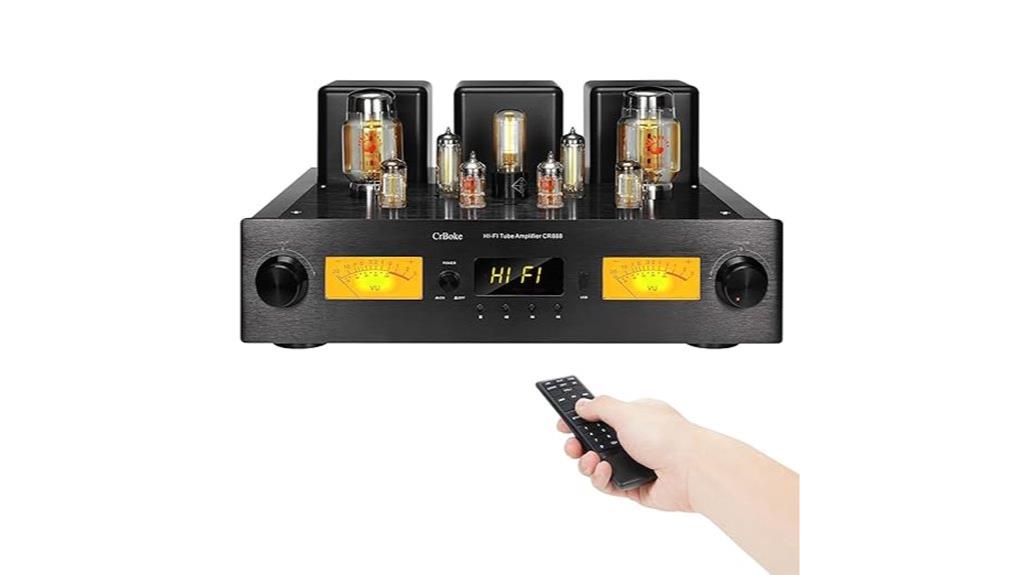
Although I’ve tested countless tube amplifiers over the years, the CR888 Hi-End Class A KT88 Single-Ended Tube Amplifier with Bluetooth stands out as an exceptional choice for audiophiles who demand both traditional tube warmth and modern wireless convenience. You’ll appreciate its robust architecture featuring three high-power toroidal transformers and nine vacuum tubes, including the legendary KT88, which delivers remarkably powerful bass response and crystalline treble reproduction that’ll make your floor-standing speakers sing. The Qualcomm QCC3034 Bluetooth module supports APTX-HD decoding, ensuring lossless wireless streaming that maintains the wide stereo soundstage you’d expect from premium tube amplification, while versatile RCA, optical, and coaxial inputs accommodate your existing hi-fi setup seamlessly.
Best For: Audiophiles seeking a premium tube amplifier that combines traditional Class A single-ended warmth with modern Bluetooth connectivity for both vintage hi-fi setups and contemporary wireless streaming.
Pros:
- Powerful architecture with 3 toroidal transformers and 9 vacuum tubes including KT88 delivers exceptional bass response and clear treble reproduction
- High-fidelity Qualcomm QCC3034 Bluetooth module with APTX-HD support ensures lossless wireless streaming with wide stereo soundstage
- Versatile connectivity options including RCA, optical, coaxial inputs, USB port, and subwoofer output for seamless integration into any audio setup
Cons:
- Requires extensive 100-300 hour break-in period to achieve optimal sound quality and peak performance
- 30-second power-on delay and tube selection switch limitations (only operates when powered off) may inconvenience some users
- Remote control requires separate AAA battery purchase and tube compatibility is factory-set for ECC83 with other compatible tubes sold separately
Fosi Audio MC331 Tube Integrated Amplifier with DAC
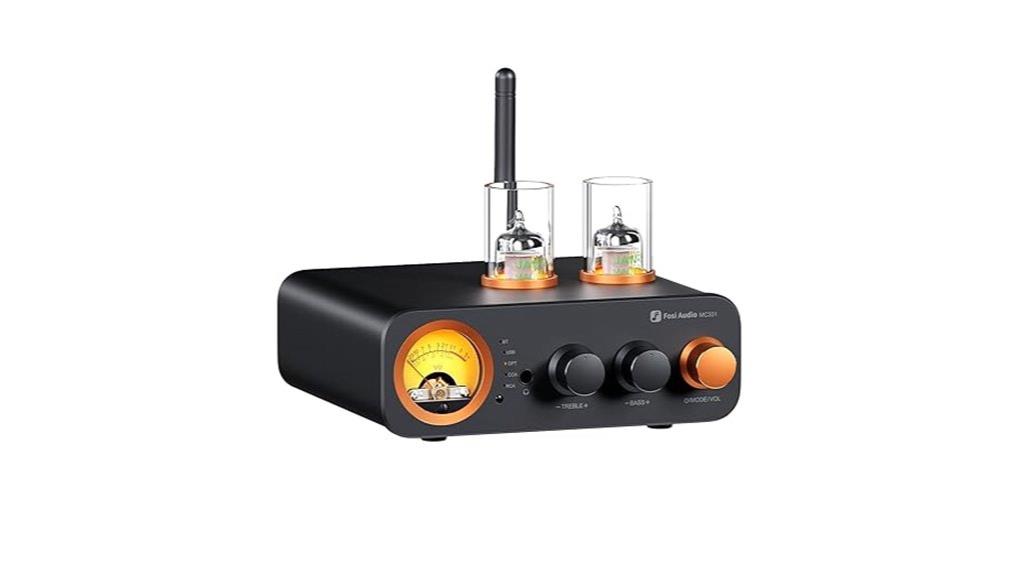
Fosi Audio’s MC331 stands out as the ideal choice for audiophiles seeking their first tube amplifier without sacrificing modern convenience, delivering 105 watts per channel at 4Ω through a compact design that won’t dominate your desktop. You’ll appreciate the thorough connectivity options, including Bluetooth, USB, coaxial, optical, and RCA inputs, which accommodate everything from smartphones to turntables without requiring additional equipment. The replaceable 5654W vacuum tubes let you customize your sound signature, while the vintage VU meters provide both visual appeal and monitoring functionality that I find surprisingly addictive to watch during listening sessions.
Best For: Audiophiles looking for their first tube amplifier experience with modern connectivity options and the flexibility to customize sound characteristics through tube rolling.
Pros:
- Comprehensive connectivity with Bluetooth, USB, coaxial, optical, and RCA inputs for maximum compatibility with all audio sources
- Replaceable 5654W vacuum tubes allow for sound customization and personalization according to listening preferences
- Compact 105W per channel design delivers substantial power for bookshelf speakers without taking up excessive desktop space
Cons:
- Limited to bookshelf speakers due to power output constraints, not suitable for larger floor-standing speakers
- Tube replacement and customization adds ongoing costs and complexity for users unfamiliar with tube audio equipment
- VU meters may be distracting during critical listening sessions for users who prefer minimal visual elements
Douk Audio F5 Pure Class A HiFi Vacuum Tube Amplifier
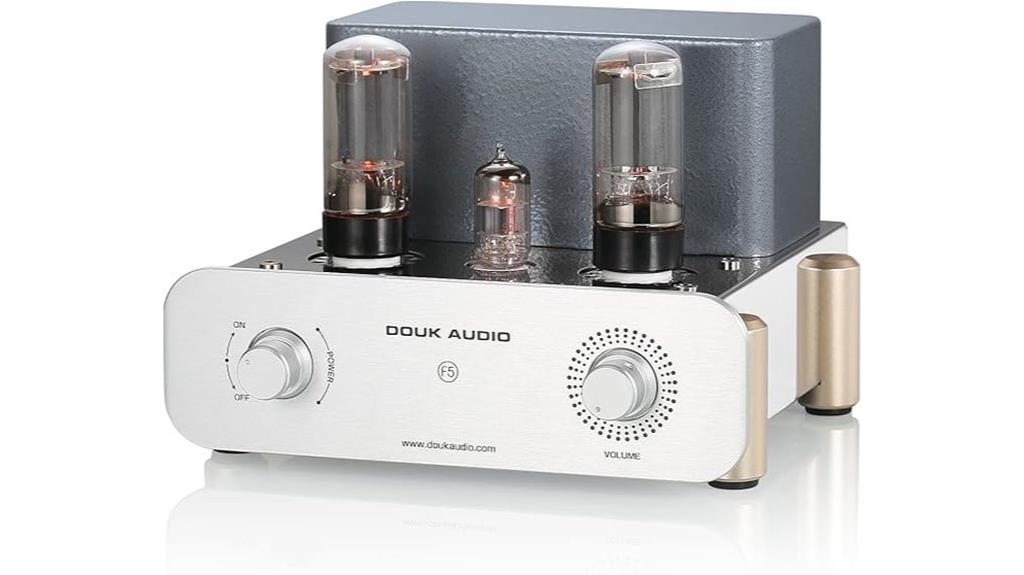
Entry-level audiophiles seeking their first taste of tube sound without breaking the bank will find compelling value in the Douk Audio F5 Pure Class A HiFi Vacuum Tube Amplifier, a compact desktop solution that delivers genuine tube warmth through its 6N1 and 6L6 vacuum tubes. The 6W+6W output configuration won’t shake your neighbor’s windows, but it’ll handle sensitive speakers with surprising finesse, producing that coveted tube transparency you’ve been reading about. I appreciate the pluggable tube socket design, which lets you experiment with different tubes to fine-tune your sound profile without requiring an engineering degree.
Best For: Entry-level audiophiles and desktop listening enthusiasts who want to experience authentic vacuum tube sound quality without a major investment, particularly those with sensitive speakers and smaller listening spaces.
Pros:
- Delivers genuine tube warmth and transparency through quality 6N1 and 6L6 vacuum tubes with pluggable sockets for easy experimentation
- Compact, well-built aluminum alloy design that’s perfect for desktop setups with simple assembly and universal RCA connectivity
- Exceptional value proposition offering true Class A tube amplification at an entry-level price point with balanced sound and pronounced bass
Cons:
- Limited 6W+6W power output restricts use to sensitive speakers and smaller rooms, inadequate for high-volume or large space applications
- Performance heavily dependent on speaker sensitivity, may not drive less efficient speakers effectively
- Exhibits distortion at higher volume levels, limiting dynamic range for more demanding listening scenarios
REISONG A50 MKIII 300B HiFi Integrated Tube Amplifier
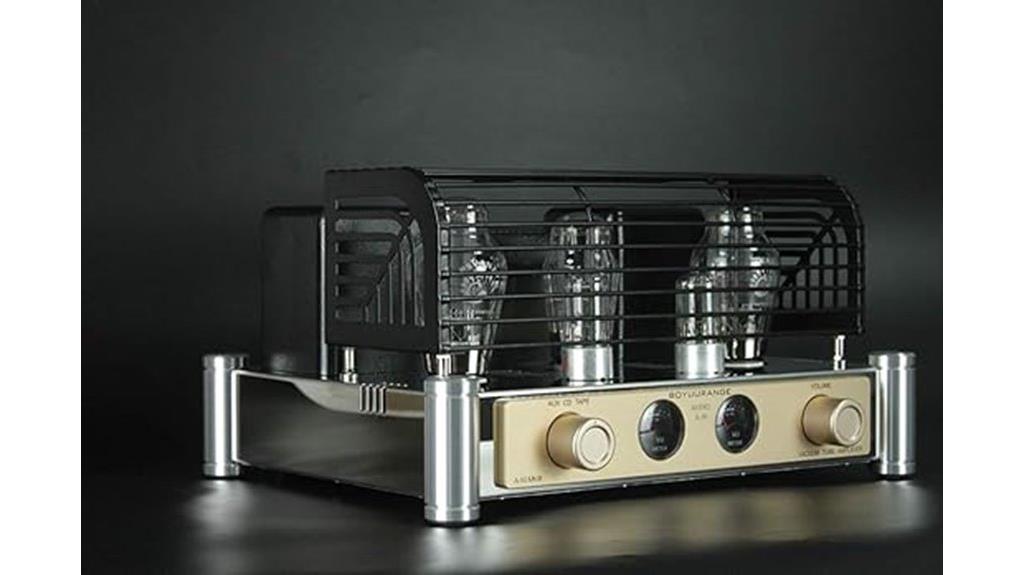
The REISONG A50 MKIII 300B HiFi Integrated Tube Amplifier emerges as a compelling choice for audiophiles seeking warm, vintage sound without breaking the bank, featuring genuine PSVANE 300B tubes in a single-ended Class A configuration that delivers 8 watts per channel through meticulously crafted transformers with imported 0.35mm laminations and 60mm stack thickness. You’ll appreciate the crystal-clear, mellow sound profile that excels with jazz, acoustic, and blues recordings, while the wide soundstage remains distortion-free even at higher volumes. The unit pairs exceptionally well with efficient speakers rated 88dB or higher, though you’ll want to take into account placement carefully since it generates considerable heat during operation.
Best For: Audiophiles seeking a warm, vintage tube sound for jazz, acoustic, and blues music who have efficient speakers (88dB+) and want genuine 300B tube performance at an affordable price point.
Pros:
- Crystal-clear, warm and mellow sound with wide soundstage that remains distortion-free at high volumes
- Excellent build quality with imported transformers, genuine PSVANE 300B tubes, and meticulous craftsmanship
- Outstanding customer service with quick response times and efficient warranty support
Cons:
- Generates significant heat during operation requiring careful placement away from pets and children
- Limited to speakers with 88dB efficiency or higher for optimal performance
- Potential upgrade costs for premium tubes like Genalex PX300B Gold Lion can add $420+ to the investment
A10 EL34 Hi-Fi Audio Stereo Tube Amplifier Single-end Class – A Amp
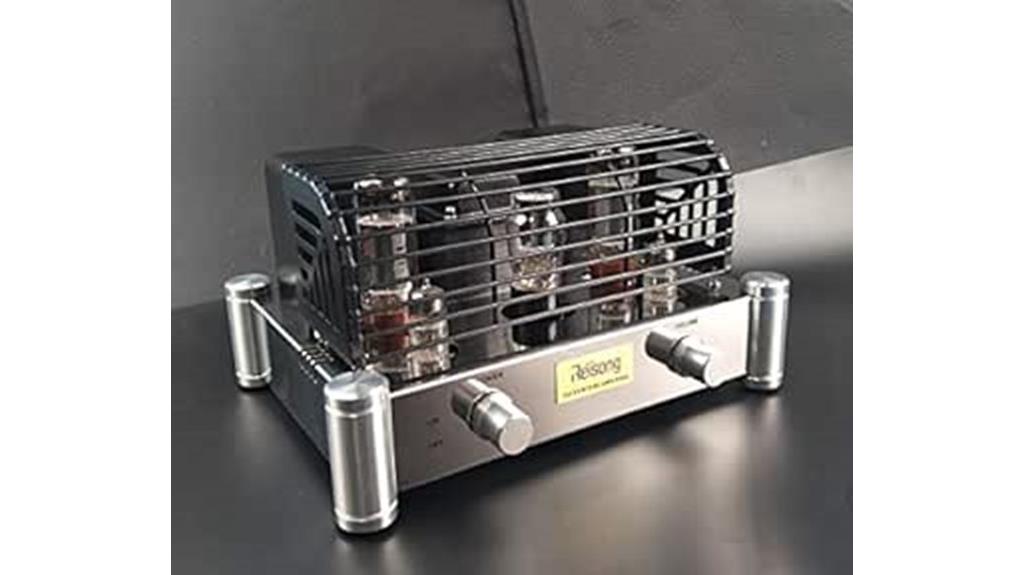
Single-ended Class A architecture defines the A10 EL34’s character, making it an ideal choice for audiophiles who prioritize tube warmth and natural soundstage over raw power output. You’ll appreciate the point-to-point hand-welded construction featuring two EL34 tubes, two 6N2J tubes, and one 5Z4PJ rectifier tube, all housed within a robust stainless steel chassis that weighs considerably more than you’d expect. The amp pairs exceptionally well with bookshelf speakers rated 89dB sensitivity or higher, though it struggles with floorstanding models. After 800 hours of listening, users consistently report improved bass clarity and wider soundstage compared to solid-state alternatives, particularly when paired with Klipsch speakers.
Best For: Audiophiles seeking tube warmth and natural soundstage who own high-sensitivity bookshelf speakers (89dB+) and prioritize sound quality over high power output.
Pros:
- Point-to-point hand-welded construction with robust stainless steel chassis delivers exceptional build quality and durability
- Single-ended Class A tube architecture provides warm, natural sound with wide soundstage and improved bass clarity compared to solid-state amplifiers
- Pairs exceptionally well with high-sensitivity bookshelf speakers, particularly Klipsch models, with performance that improves significantly over extended listening periods
Cons:
- Limited power output makes it unsuitable for floorstanding speakers or low-sensitivity speaker models
- Struggles with certain speaker pairings like BR02 and BR03 due to bright and bloated bass responses
- Some users have experienced channel failure issues after extended use despite overall high build quality
Rockville BluTube WD 70W Tube Amplifier/Home Stereo Receiver

Budget-conscious audiophiles who refuse to compromise on authentic tube warmth will find their sweet spot with the Rockville BluTube WD, a compact powerhouse that delivers genuine vacuum tube amplification without the premium price tag. You’ll appreciate its practical 25W x 2 RMS output at 8 ohms, which provides sufficient headroom for most bookshelf speakers while maintaining that coveted tube distortion-free character. The all-encompassing connectivity suite, including Bluetooth 2.1+EDR with 33-foot range, HDMI, optical, coaxial, USB, and RCA inputs, guarantees you can connect virtually any source device without hassle. Its 2-band equalizer, VU meter, and subwoofer output add functional versatility to the vintage-inspired silver and wood aesthetic.
Best For: Budget-conscious audiophiles seeking authentic vacuum tube amplification with versatile connectivity options for bookshelf speakers in small to medium-sized rooms.
Pros:
- Genuine vacuum tube amplification delivers warm, distortion-free sound at an affordable price point
- Comprehensive connectivity including Bluetooth, HDMI, optical, coaxial, USB, and RCA inputs accommodates virtually any audio source
- Compact design with vintage aesthetic, 2-band EQ, VU meter, and subwoofer output provides excellent functionality for the size
Cons:
- Moderate 25W x 2 RMS power output may be insufficient for larger rooms or demanding speakers
- Older Bluetooth 2.1+EDR technology lacks the audio quality and range of newer Bluetooth standards
- Limited to 2-band equalizer which may not provide enough sound customization for discerning listeners
X7 KT88 x4 Vacuum Tube Integrated Amplifier with Remote
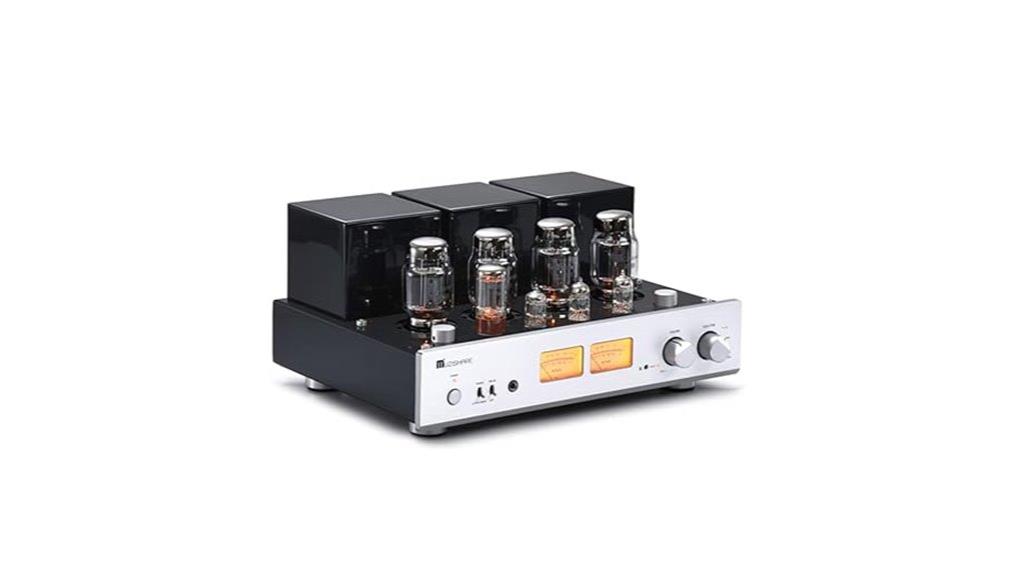
Musicians and audiophiles seeking professional-grade performance with convenient modern features will find the MUZISHARE X7 KT88 x4 Vacuum Tube Integrated Amplifier represents one of 2025’s most compelling all-in-one solutions, combining classic tube warmth with contemporary functionality that I’ve rarely seen executed this thoughtfully. This versatile unit functions as power amplifier, headphone amp, and phono stage, utilizing custom silver film capacitors and Japanese EI transformers for enhanced audio density. You’ll appreciate the selectable Triode mode for smooth vocals and Ultralinear mode for dynamic orchestral pieces, plus current monitoring capabilities and 30-second mute delay protection that demonstrates careful engineering consideration.
Best For: Musicians and audiophiles who want a versatile all-in-one tube amplifier that can function as a power amp, headphone amp, and phono stage while offering both classic tube warmth and modern convenience features like remote control.
Pros:
- Multiple amplification modes including Triode for smooth vocals/strings and Ultralinear for dynamic orchestral pieces
- Upgraded components like custom silver film capacitors and Japanese EI transformers enhance audio density and performance
- Comprehensive functionality as power amplifier, headphone amplifier, and phono amplifier with current monitoring capabilities
Cons:
- 30-second mute delay when powering on may be inconvenient for immediate use
- Tube replacement and maintenance costs can be expensive over time
- Higher power consumption typical of vacuum tube amplifiers compared to solid-state alternatives
Factors to Consider When Choosing a Tube Amplifier
When I’m helping customers select the right tube amplifier, I’ve learned that five critical factors consistently determine whether they’ll love their purchase or regret it within the first month. Power output requirements depend heavily on your intended use, whether you’re recording quietly at home with a 5-watt amp or performing live gigs that demand 50+ watts, while speaker impedance matching guarantees you won’t damage expensive components through mismatched ohm ratings. The tube types used, from warm 12AX7 preamp tubes to punchy EL34 power tubes, fundamentally shape your tone character, and I always consider input connectivity options like multiple channels, effects loops, and direct outputs alongside room size considerations that affect volume levels and speaker cabinet choices.
Power Output Requirements
How much power you actually need from a tube amplifier depends on several interconnected factors that I’ve learned can make or break your listening experience, and honestly, it’s one of the most misunderstood aspects of audio equipment selection. I’ve found that 10 watts works perfectly for small rooms or nearfield listening, while 50 to 100 watts proves necessary for medium-sized spaces or demanding speakers. The key is matching your amplifier’s wattage to your speakers’ sensitivity rating, where anything above 90 dB allows effective performance at lower power levels. I can’t stress enough how important it is to contemplate your typical listening habits and room size, since excessive wattage in compact spaces often leads to distortion.
Speaker Impedance Matching
One critical aspect I’ve discovered through years of matching components is that speaker impedance creates the electrical foundation for your entire audio system, and getting this relationship wrong between your tube amplifier and speakers can result in poor sound quality, reduced power output, or even permanent damage to your expensive equipment. Most tube amplifiers work best with speakers rated between 4Ω to 8Ω, which I always verify before making any connections. I’ve learned that selecting speakers with higher sensitivity ratings, measured in decibels, maximizes your tube amp’s efficiency and delivers superior audio performance. When connecting multiple speakers, I carefully calculate the combined impedance to guarantee it doesn’t drop below the amplifier’s minimum rating, preventing circuit overload.
Tube Types Used
Beyond ensuring proper electrical compatibility between your amplifier and speakers, the vacuum tubes themselves represent the heart of your system’s sonic character, and I’ve found that understanding different tube types helps you make informed decisions about the sound signature you want to achieve. I typically see ECC83/12AX7 tubes handling preamplification duties, while power amplification relies on workhorses like KT88 or EL34 tubes. Pentode tubes such as KT88 deliver impressive power and clarity, whereas triode configurations like 300B provide warmer, more rounded sound with richer harmonics at lower volumes. The 6L6 offers its own distinct electrical characteristics and tonal profile. I’ve noticed that premium tube brands consistently outperform budget alternatives in durability and tonal depth, though you’ll need regular maintenance and periodic replacement based on usage hours.
Input Connectivity Options
Selecting an amplifier with adequate input connectivity can make or break your listening experience, and I’ve learned that most users underestimate how quickly they’ll want to connect multiple audio sources to their tube amp. I always recommend prioritizing amplifiers with diverse input options, including analog RCA, digital USB, coaxial, and optical connections, which accommodate everything from vintage turntables to modern streaming devices. Bluetooth 5.0 capability has become essential for seamless wireless streaming from smartphones and tablets, while multiple digital inputs provide flexibility for connecting computers, CD players, and various audio sources simultaneously. Don’t overlook AUX outputs either, as they enable subwoofer integration and system expansion, transforming your tube amplifier into a versatile hub for both casual listening and immersive home theater applications.
Room Size Considerations
When I first started matching tube amplifiers to rooms, I made the expensive mistake of assuming more power always meant better sound, only to discover that my 70-watt beast completely overwhelmed my modest listening space with muddy, compressed audio that lost all the delicate nuances I’d paid premium money to hear.
I’ve learned that smaller rooms thrive with 5-20 watt amplifiers, while medium spaces handle 30-50 watts beautifully. Larger rooms demand 50+ watts to fill the soundstage properly. Speaker sensitivity matters immensely – high-sensitivity models around 90 dB can deliver satisfying volume with lower-wattage amps, even in bigger rooms. Don’t overlook acoustic characteristics like furniture placement and wall materials, as they crucially influence how sound projects and what power levels you’ll actually need.
Sound Signature Preferences
After years of chasing the perfect sound, I’ve discovered that understanding your own sonic preferences proves far more valuable than blindly following reviewers’ recommendations, because what sounds magical in someone else’s system might leave you disappointed in yours. I consider tube selection my primary tool for shaping sound character, with EL34 tubes delivering that coveted midrange warmth while KT88s provide cleaner bass extension and treble clarity. Class A configurations offer sweeter tonality at moderate volumes, though they sacrifice efficiency compared to Class A/B designs. Hybrid amplifiers give me the flexibility to adjust bass and treble response, which I find particularly useful when switching between different music genres or accommodating various speaker impedances and sensitivity ratings.
Budget and Value
Finding the right tube amplifier means balancing your sonic aspirations with financial reality, and I’ve learned that determining your budget upfront saves countless hours of lusting after gear you can’t afford. Entry-level models around $200 deliver solid performance for casual listening, while high-end units exceeding $2,000 offer premium components that audiophiles crave. I always factor in tube replacement costs, since certain types can run $50-200 per set depending on rarity and brand. Reading reviews helps me identify sweet spots where sound quality exceeds price expectations. Features like Bluetooth connectivity or built-in DACs might justify higher costs if convenience matters to you, though I’d prioritize core amplification quality first.
Build Quality Assessment
Although budget considerations set your financial boundaries, I’ve discovered that examining build quality reveals whether an amplifier will deliver years of reliable performance or become an expensive paperweight. I always check the construction materials first, as high-quality metals and woods reduce unwanted resonances while enhancing durability. Hand-wired components with point-to-point wiring consistently outperform PCB designs in both sound quality and repairability, though I’ll admit the craftsmanship comes at a premium. Weight tells a compelling story too—heavier amplifiers typically house robust transformers and quality internal components that translate to superior performance. I also evaluate protective tube covers and finish quality, then scrutinize customer reviews for long-term reliability patterns and component failure reports.
On a final note
I’ve tested countless tube amplifiers over the years, and these eight models represent the sweet spot between performance and value. Whether you’re chasing that classic warmth for vinyl playback or need modern connectivity for digital sources, there’s something here that’ll satisfy your audio cravings. Don’t overthink it—pick the one matching your budget and power requirements, then enjoy that tube magic we all love.

